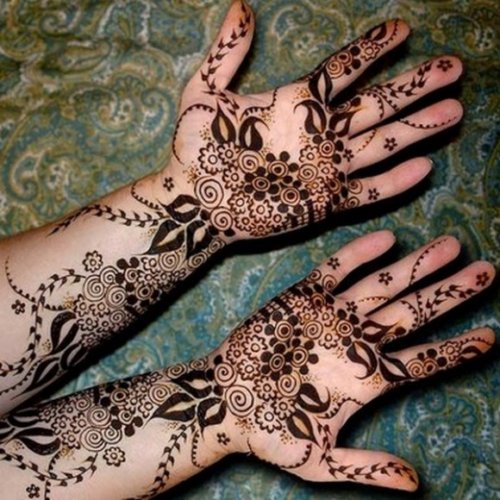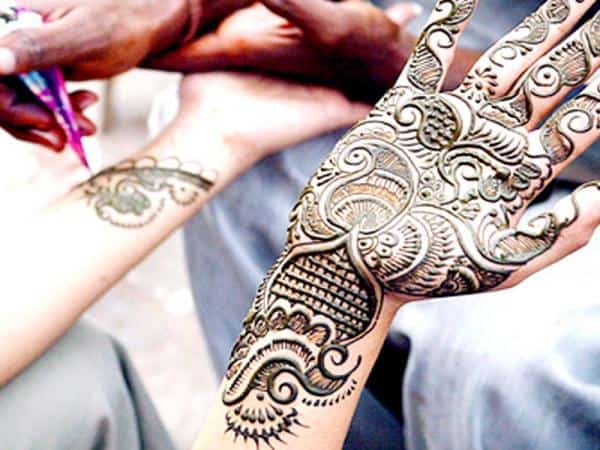Henna Mehandi Design Biography
source(google.com.pk)
The Mughals brought Mehendi to India as lately as the 12th century AD. As the use of Mehendi spread, its applicationAccording to professional henna artist and researcher Catherine C Jones, the beautiful patterning prevalent in India today has emerged only in the 20th century. In 17th century India, the barber’s wife was usually employed for applying henna on women. Most women from that time in India are depicted with their hands and feet hennaed, regardless of social class or marital status.
The art of Mehendi has existed for centuries. The exact place of its origin is difficult to track because of centuries of people in different cultures moving through the continents and taking their art forms with them and therefore sharing their art with everyone along the way.
Some historical evidence suggests that Mehendi started in India while others believe it was introduced to India during the twelfth century A.D. I personally feel that it would be hard to argue the fact that it appeared as an art form in Egypt first.
Proof has been found that henna(Mehendi) was used to stain the fingers and toes of Pharoahs prior to mummification over 5000 years ago when it was also used as a cosmetic and for it’s healing power. The mummification process took 70 days and as the Egyptians were diligent in planning for their deaths and their rebirth in the afterlife, they became quite obsessed with the preservation process. The Egyptians believed that body art ensured their acceptance into the afterlife and therefore used tattooing and Mehendi to please the gods and guarantee a pleasant trip.
The henna used for mehendi comes from a bush called Lawsonia Inermis which is part of the loose strife family and is grown in the Sudan, Egypt, India, most of the North African counties, The Middle East and other hot and dry places. The bush is also grown in Florida and California for his ornamental appearance and often grows to be quite large, ranging from six to twenty feet in some cases. The lance- shaped leaves from the bush are harvested, dried and then crushed to make the henna powder. Henna is used for hair dye, as a skin conditioner and as a reliever for rashes. The art of Mehendi isapnimarzi 4 referred to as henna, mehndi or mehandi depending on where you are and which name you feel came first (or are most comfortable using). No matter what you call it though — the art form remains essentially the same as it was centuries ago. It is beautiful the way it stains the skin!
Henna Mehandi Design Patterns Images Book For Hand Dresses For Kids Images Flowers Arabic On Paper Balck And White Simple

Henna Mehandi Design Patterns Images Book For Hand Dresses For Kids Images Flowers Arabic On Paper Balck And White Simple

Henna Mehandi Design Patterns Images Book For Hand Dresses For Kids Images Flowers Arabic On Paper Balck And White Simple

Henna Mehandi Design Patterns Images Book For Hand Dresses For Kids Images Flowers Arabic On Paper Balck And White Simple

Henna Mehandi Design Patterns Images Book For Hand Dresses For Kids Images Flowers Arabic On Paper Balck And White Simple

Henna Mehandi Design Patterns Images Book For Hand Dresses For Kids Images Flowers Arabic On Paper Balck And White Simple

Henna Mehandi Design Patterns Images Book For Hand Dresses For Kids Images Flowers Arabic On Paper Balck And White Simple

Henna Mehandi Design Patterns Images Book For Hand Dresses For Kids Images Flowers Arabic On Paper Balck And White Simple
Henna Mehandi Design Patterns Images Book For Hand Dresses For Kids Images Flowers Arabic On Paper Balck And White Simple

Henna Mehandi Design Patterns Images Book For Hand Dresses For Kids Images Flowers Arabic On Paper Balck And White Simple


0 comments:
Post a Comment